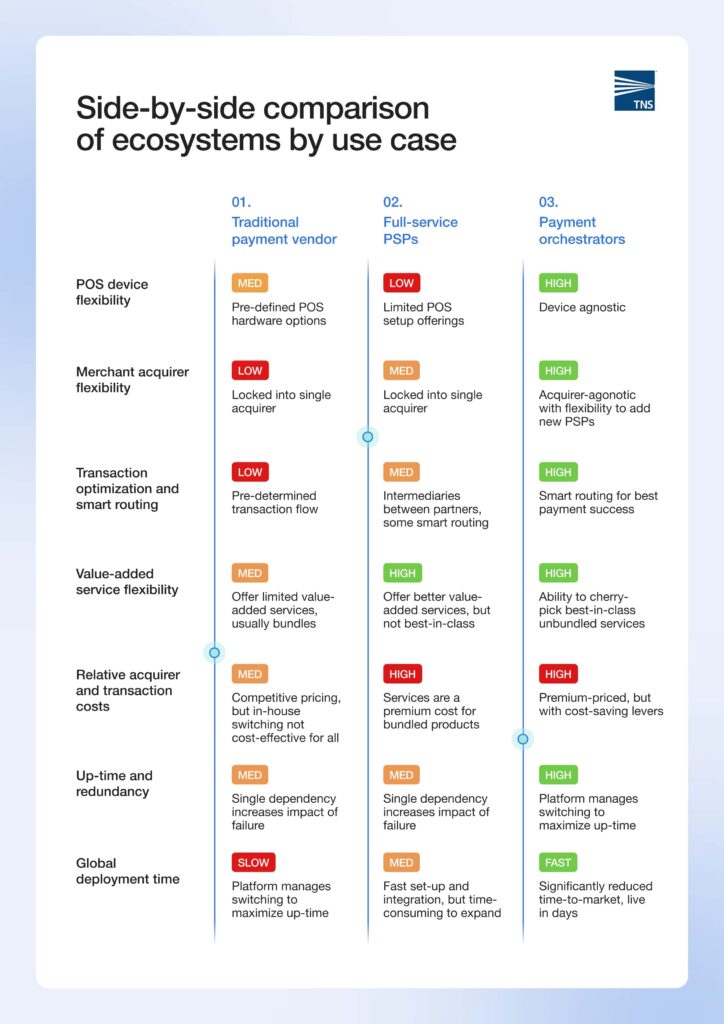In a recent blog post, we discussed how many businesses are struggling to manage the increasing complications of their payment stacks. To solve this challenge, the industry is shifting towards payment orchestration – a solution that cherry-picks new payments services from best-of-breed providers while maintaining a single technical solution provider.
Discover the benefits of a payment orchestration layer for your business.
A Payment Orchestration Layer Helps Implement a True Vendor-Flexible Solution
Your payment ecosystem must accommodate a dizzying array of providers – to accept credit card transactions and alternative payment methods (APMs) and connect with acquirers, issuing banks, tools and more.
Using multiple endpoints and providers is a flexible solution, but in reality, maintaining each relationship with the different providers separately requires significant internal resources and business strain.
Payment orchestration maintains the flexibility of individual connections, but through an orchestration layer that acts as a unified single technical middle layer between the merchant and providers.
The orchestration layer is a unification of payments, technology, hardware, and connectivity – alleviating the merchant’s pressure from a disjointed payment network, streamlining the entire payment infrastructure via a single point of reference.
No wonder it’s quickly becoming the ecosystem choice for so many mid-size enterprises.

Benefits of a Payment Orchestration Layer
For businesses buckling under the pressures of accepting alternative payment methods (APMs), protecting their transactions from fraud and connecting with dozens of bespoke endpoints, payment orchestration provides numerous benefits.
Improved Merchant Experience and Operational Flexibility
With payment orchestration, merchants have flexibility to assemble payment components and design a payment operating model for their unique needs – and a single API integration hides the complexity of multiple API integrations.
Easy Facilitation of a Resilient Acquirer-Agnostic Environment
Payment orchestration frees merchants from a single acquirer limitation set up, enabling an easier solution to managing connections with multiple acquirers, alternative payment methods.
This can lead to improved resiliency and uptime of connections, too. Merchants can connect to various POS terminal providers, merchant acquirers/PSPs and other value-added service providers.
Optimization of Transaction Acceptance and Checkout Conversions
With the right provider integrations, payment orchestration can help improve conversion rates and business revenue. For example, smart routing routes transactions to the acquiring bank or payment partners with better authorization rates.
Minimized Business Operational and Processing Costs
Because payment orchestration is a single layer, merchants adopt a simplified contracting model rather than multiple contracts with PSPs and/or acquirers and other providers. Merchants can connect directly to local acquirers, which is economically cheaper as it bypasses pricing premiums from PSPs and other partners.
Accelerated Time to Markets
Unified payment orchestration facilitates merchants’ ability to rapidly integrate, test, and launch new connections to be more agile and responsive to customer needs and new commerce use cases.
Activating acquirer, PSP, or APM connections within days removes payments as a go-to-market bottleneck to business expansion.
Streamlined Reconciliation and Unified Data Insights
When these components are integrated into a single layer, then all payment data via multiple back-end connections can be aggregated and synthesized, which streamlines the reconciliation process. And with an aggregated view of data, value-added applications can drive actionable business insights.
A Payment Orchestration Layer Simplifies Payments
Regardless of business size and industry, merchants are grappling with how to deliver the kinds of experiences modern customers expect, while ensuring they give their payment team a comprehensive and seamless solution.
In our last post, we discussed 7 things you need to consider for your payment ecosystem. Payment orchestration checks all the boxes.
- APM-enabled
- Risk-reducing
- Flexible
- Omnichannel
- Scalable
- Compliant
- Easily managed
How does this compare to other types of payment ecosystems?
A traditional payment ecosystem ranks high for agility, but leaves businesses to patch together the disparate solutions, which can become difficult and expensive in-house.
Single-acquirer solutions are a quick and easy solution for small businesses, but are difficult to scale as the business grows.
Full-service PSPs provide all-in-one seamless solutions. However, many enterprises are frustrated by the lack of best-in-class tools available to suit their specific needs.
A payment orchestration platform enables enterprises to pick the best-in-class services to meet their needs, but still access the range of services through a simplified API layer. This can help reduce the time, cost and complexity of expanding online and in-person commerce use cases and integrating new providers across markets.
Payment Orchestration is Part of TNS’ Complete Commerce Solution
Complete Commerce is a full-stack payment and network capability delivered as a managed service, enabling your business to:
Accept Payments
Allow customers to choose their preferred way to pay, online or in-person with TNS’ range of POS terminals – unattended, at the pump or in-store.
Connect Anytime
Securely connect payment devices, sites or cloud environments via its range of managed connectivity services to any destination with a secure PCI DSS- certified and carrier-agnostic global network.
Orchestrate Transactions
Process and route any transaction, to any payment provider, globally, via its cloud-native payment platform.

Read the Full Report
Learn more about how payment orchestration is simplifying payments for merchants in our report, Navigating in-person and online payment complexity.




